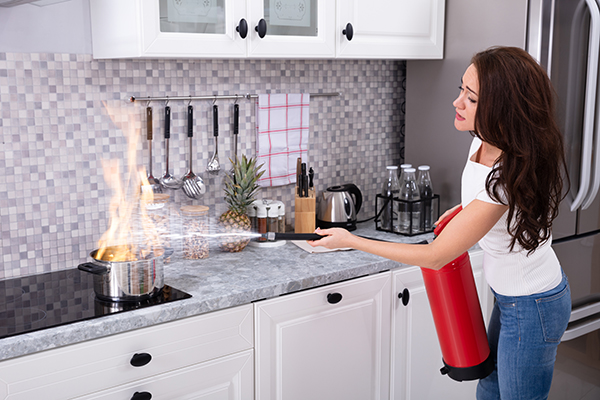Survival 101: How to properly handle everyday flammables
By zoeysky // 2025-04-22
Tweet
Share
Copy

- Everyday items (car fuels, generators) and human errors (improper storage, spills) create fire risks. Leaks or infrastructure failures can turn ordinary spaces into tinderboxes.
- Protect yourself with goggles, respirators, flame-resistant cotton clothing, safety boots, gloves and fireproof blankets to prevent burns and fume exposure.
- Work in ventilated areas, avoid sparks near fuels, store materials in approved containers and use tools (e.g., pumps) to reduce chemical spills.
- Contain leaks with absorbents and never use water on flammable liquids. Clean spills thoroughly using spill kits and safely dispose of waste.
- Train for burns and fire drills, foster a culture of vigilance and practice preemptive choices (e.g., cotton over synthetics) to build layered defenses.
Personal protective equipment (PPE): Your lifesaving "armor"
Think of personal protective equipment (PPE) as your "shield" on the battlefield of emergencies, especially if you work with hazardous materials. Below are some PPE must-haves to protect yourself against fiery dangers:Eye and respiratory protection
Safety goggles shield your eyes from splashes and flying debris. Gasoline fumes, which can erode lung tissue over time, demand a good particulate/organic vapor mask for anyone working in confined spaces.Flame-resistant clothing
Coveralls made for industrial use aren’t stylish, but they’re a must-have. They prevent flames from singeing your skin, guard against spills and shield your knees during tough chores. Opt for natural fibers like cotton and avoid synthetics because nylon or polyester can melt and worsen burn injuries.Safety boots
Sturdy steel-toe boots protect toes, ankles and feet from spills, falling debris or accidental kicks. They’re not just for survivalists, they’re a no-brainer when handling heavy-duty tasks.Fireproof gloves
When transferring fuel or wrenching on parts, gloves act as a barrier against caustic liquids and abrasions. Invest in quality because cheap pairs might deteriorate faster. (Related: Survival basics: How to stay alive when the unexpected happens.)Fireproof blankets
Fireproof blankets are the unsung heroes for smothering fires, especially flaming liquids or overheating lithium-ion batteries. Keep a few on hand because they can save your property and life when SHTF.Extra safety measures: Go above and beyond
PPE alone isn’t enough. You must adopt a mindset of proactive vigilance to prevent accidents from happening in the first place.Proper ventilation
Always work in open, well-ventilated areas. Fumes can accumulate unseen, leading to both explosions and health hazards. Use fans or move outside if possible.Eliminate sparks
No smoking zones are a given but watch out for electric sparks. Avoid starting engines or using tools near spills because the sparks from starters, brakes or faulty wiring can ignite vapors.Smart storage
Store fuel in approved containers and away from heat. Modern fuels like ethanol-blended gas are more volatile so they need dedicated, stable shelving.Use the right tools
Invest in approved fuel pumps and transfer equipment. Manual pours increase spill risks and fatigue, especially in high-stress environments. If you're worried about small fires, know that preppers can still live comfortably by taking necessary precautions. Swap polyester for cotton work shirts, keep duct tape handy for quick container repairs and practice using spill kits regularly. A spill kit is a set of equipment designed to remove hazardous substances quickly and efficiently if they spill. It is intended for use on small spills or leaks of various substances. The materials in a spill kit can be used to limit the spread of a substance so it can safely be neutralized and disposed of.Spill response and cleanup: Stay calm, act swiftly
Accidents happen anywhere at any time. Fortunately, you can prepare for them. Follow the tips below to clean up spills safely:Keep emergency contacts visible
Families and groups should know fire response hotlines and routes out of danger zones. Rehearse escapes and fire extinguisher use regularly.Contain the spill
Use absorbent granules, rags or sand (non-flammable) to corral liquid. Never use water on flammable liquids because water will only spread the problem.Clean thoroughly
Follow protocols for hazardous waste disposal and don’t just flush spills into drains.First aid for burns: Cool, cover and seek help
Even the most prepared can slip up. If burns occur:Stop, drop and roll
If clothing catches fire, put out the flames instantly. Flame-resistant gear buys critical seconds that can save a life or prevent severe injuries.Cool the burn
If someone is injured, run cool (not icy) water over the burn for 10 to 15 minutes. This prevents further tissue damage.Protect the wound
Loosely cover minor burns with sterile gauze. Avoid bandages or creams if the skin is blistered.Seek medical care
Facial or major burns require professional attention immediately. For minor burns, aloe vera, a natural go-to, can soothe the pain and aid healing. Note that aloe is no substitute for severe cases. Crisis demands more than resilience; it calls for foresight. By wearing PPE, investing in fireproof materials and training your crew, you mitigate risks and empower your community to stay safe. Every prudent choice, such as choosing cotton over synthetics, inspecting fuel lines regularly and practicing "what if" drills, adds another layer of defense. Remember, you’re not just protecting yourself; you’re securing the backbone of your family’s or group’s survival. The stakes are high, but with knowledge and preparedness, you can turn those "disaster movie" moments into mere plot twists and live to share the story. Visit Survival.news for more tips on how to survive other dangerous scenarios. You can also visit Health Ranger Store and Brighteon Store for must-have supplies for your prepping needs. Watch this clip about the mysterious sky explosions over California. This video is from the Saturnis channel on Brighteon.com.More related stories:
Electric vehicles in Florida CATCH FIRE after coming into contact with saltwater from Hurricane Idalia. Natural cleaning alternatives: Safe products for a healthier home. 7 Must-have multi-functional survival tools for every prepper. ANOTHER chemical plant catches fire and explodes, this time near HOUSTON: “We have a problem.” Sources include: TheOrganicPrepper.com Humanfocus.co.uk Blog.Storemasta.com.au OSHATrainingSchool.com Brighteon.comTweet
Share
Copy
Tagged Under:
preparedness prepping disaster survival self-defense toxic chemicals SHTF prepper homesteading off grid emergency preparedness survival gear dangerous gear fires Survival Tips how-to safety precautions flammables flammable materials
You Might Also Like
By Finn Heartley // Share
‘Toxic cocktail’: study finds almost 200 pesticides in European homes
By S.D. Wells // Share
Trump administration considers ABANDONING Ukraine peace talks if no progress is made
By Ramon Tomey // Share
Recent News
Trump meets retail CEOs to address tariff concerns as trade tensions rise
By isabelle // Share
The humble Yam: A nutritious root vegetable that can elevate your meals
By lauraharris // Share










